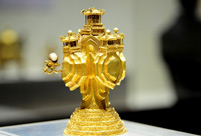

Engineers at Nasa have also been drawing up plans to use nuclear thermal propulsion in a mission to Mars in 2033.
According to the space agency's design, uranium-235 nuclear reactions are used to heat liquid hydrogen inside a reactor, turning it into ionized hydrogen gas, or plasma.
This plasma is then channeled through a rocket nozzle to generate thrust.
The proposed Copernicus spacecraft would use nuclear thermal propulsion to carry astronauts to Mars
A schematic of the nuclear thermal rocket shows how liquid hydrogen propellant would heated by the reactor
Dr Stanely Borowski, an engineer at Nasa's John Glenn Research Centre, last year outlined how this could then be used to propel a space with its crew through space in a official Nasa paper.
He said the spacecraft, called Copernicus, would consist of separate cargo and crewed transfer vehicles, each powered by a nuclear thermal propuslion stage.
These would be constructed from a 'core' that use three engines each capable of producing thrust of around 25,000 lbs of force.
He estimates that these vehicles could make the 40 million mile trip to Mars within 100 days.
It took the Mars Science Laboratory spacecraft carrying Nasa's Curiosity Rover to Mars 253 days to reach the red planet.
Writing in his paper, Dr Borowski said: 'The analysis presented here indicates transit time reductions as much as 50 per cent are possible.'
Nasa first began researching nuclear thermal rockets as part of its Nuclear Engine for Rocket Vehicle Application (NERVA) programme in 1959.
 |  |
 Thai most beautiful transgender Nong Poy release new photos
Thai most beautiful transgender Nong Poy release new photos Now and then photos of Shanghai Jiaotong University
Now and then photos of Shanghai Jiaotong University Is this what air travel will look like in 2050?
Is this what air travel will look like in 2050? Aerial view of watermelon terraces in S China's Baise
Aerial view of watermelon terraces in S China's Baise Traditional wedding of a post-80s Tibetan couple
Traditional wedding of a post-80s Tibetan couple Models in cheongsams present classical oriental beauty
Models in cheongsams present classical oriental beauty Second commissioned C28A corvette made by China enters Algerian Navy
Second commissioned C28A corvette made by China enters Algerian Navy Intoxicating Wuyuan in spring
Intoxicating Wuyuan in spring Gold and silver wares of Qing Dynasty exhibited in Shenyang Imperial Palace
Gold and silver wares of Qing Dynasty exhibited in Shenyang Imperial Palace Top 20 hottest women in the world in 2014
Top 20 hottest women in the world in 2014 Top 10 hardest languages to learn
Top 10 hardest languages to learn 10 Chinese female stars with most beautiful faces
10 Chinese female stars with most beautiful faces China’s Top 10 Unique Bridges, Highways and Roads
China’s Top 10 Unique Bridges, Highways and Roads Meet Beijing’s hottest new trend: vaping
Meet Beijing’s hottest new trend: vaping Govt to increase scrutiny of online retail: report
Govt to increase scrutiny of online retail: report China’s logistic hub in Djibouti to stabilize region, protect interests
China’s logistic hub in Djibouti to stabilize region, protect interests Myanmar won’t distance itself from China
Myanmar won’t distance itself from ChinaDay|Week